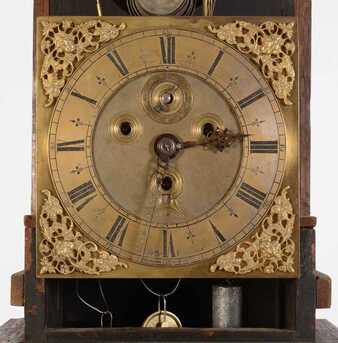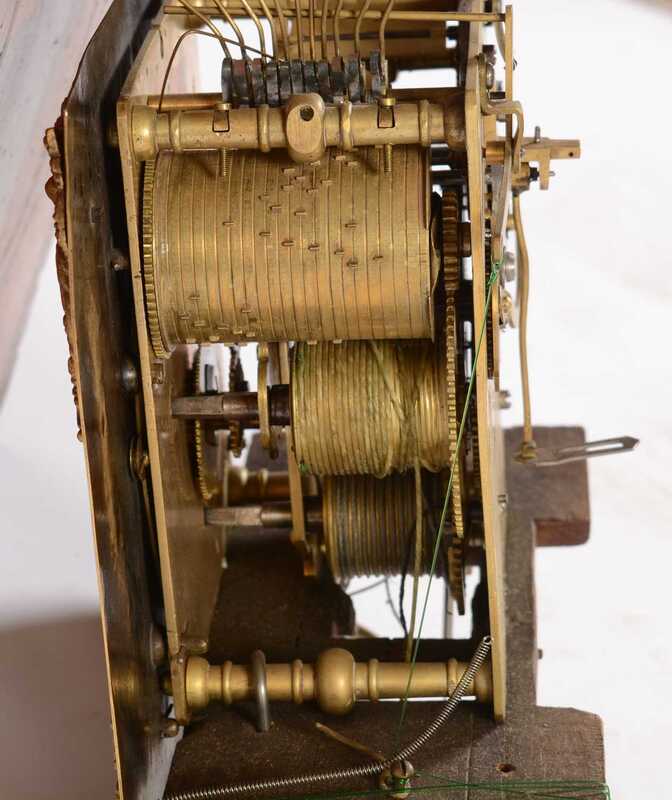|
In 2003 the Antiquarian Horological Society organised an exhibition of the finest 17th century clocks made by the leading clockmakers in England, which were illustrated and described in their book “Horological Masterworks”. Clocks by Ahasuerus Fromanteel, Edward East, William Clement, Joseph Knibb, Thomas Tompion, Henry Jones, Daniel Quare and Christopher Gould, were illustrated among the 53 entries, as well as some lesser-known clockmakers. In the section of the book entitled “Perfection” was a year duration longcase clock by ‘William Prevost of Newcastle’ in a fine marquetry case, made c.1695 (also illustrated in Early Clock and Watchmakers of the Blacksmiths’ Co. Fig. 8/110). So, who was this relatively unknown clockmaker making outstanding clocks in Newcastle, as fine as the best clockmakers in England at the end of the 17th century?
The movement (fig.3) has an anchor escapement and rear locking-plate striking. The third train of the movement operates the musical drum with its 11 bells, made c. 1690. This musical drum arrangement is very similar to a musical clock and musical movement illustrated in Horological Masterworks, both made by Ahaseurus Fromanteel c.1665. Prevost did not just make clocks while in Newcastle c.1687-1699, but also sold other things. On 5th June 1692 Sir Thomas Haggerston of Haggerston Castle, Nd., recorded in his accounts that he purchased a fine riding mask for 10/- and had three watches repaired by ‘Mr. Prouve’, costing 8/-.
A daughter Frances, born about 1698 in Newcastle who married Philip Barraud, merchant of Greenwich, about 1720 and they had two sons, Philip (b 1724), who became an engraver and Francis Gabriel(b1727-1795), who became a watchmaker. Philip Barraud senior died in January 1731/2 and was buried at St Alfege, Greenwich on 1st Feb. 1731/2. We know that Francis Gabriel Barraud, son of Philip a deceased merchant of Greenwich, was apprenticed to John Neale, watchmaker, on 2nd Mar 1741/2 in the Skinners’ Company and freed c.1750. Francis bound five apprentices between 1755-1767 including his son Paul Philip Barraud on 7th April 1767 in the Skinners’ Co., when he was working in St Giles in the Fields parish as a watchmaker. Paul Philip Barraud was freed in 1774 and worked for his father until 1795 when he took over the business by which time the workshop was in Fleet Street. Paul Philip Barraud joined the C.C. in 1796 and ran the family business until his death in 1820. Cedric Jagger has extensively researched the Barraud family including the watches and chronometers they made but we still do not know much about William Prevost’s early life and where he was trained. Looking at the clocks Prevost produced one wonders if he could have been trained in the Fromanteel workshop? Brian Loomes tells us that Ahaseurus Fromanteel left London during the Plague of 1665 but was in the Hague in 1668 on business with his son Abraham Fromanteel. Abraham was in Newcastle from about 1669-1680 where he bound Deodatus Threlkeld as an apprentice from 1671-1678.
William Prevost would have been almost half-way through his term of apprenticeship in 1680. The knowledge that Abraham Fromanteel had about the wealthy merchants in Newcastle would have been very useful to William when he later went there and sold his wonderful year duration clock to a merchant who needed information about the tides down the East coast for ships taking goods to London. When Abraham eventually returned to Newcastle in 1711 he must have taken a year duration clock with him because he raffled a year clock for 10/- shillings a ticket which he advertised in the Newcastle Courant on Monday 20th August 1711 (Bates). We cannot conclude that Prevost was trained in the Fromanteel workshop until we have more evidence, but it was a possibility. Meanwhile we can admire the outstanding clocks he made during his brief stay in Newcastle.
We do not know how long Prevost worked in London after 1700, his death has not been recorded, but there were at least two other William Prevost working at the same time as the clockmaker. William Prevost surgeon was buried at St. Mary Le Strand on 24 Nov., 1703. William Prevost a fan-maker of Soho, married Susanne Lienard in 1698 and later married Anne Angibaud in 1706. If you are interested in any of the clockmakers and watchmakers mentioned in this blog, you might consider my latest book, Early clock and watchmakers in the Blacksmith's Company.
0 Comments
|
AuthorKeith Bates is an amateur horologist who has been researching clocks, watches and chronometers and their makers for over 30 years. Archives
August 2023
Categories
All
|




 RSS Feed
RSS Feed